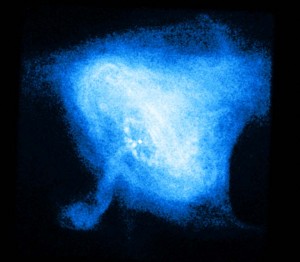On March 1, 2012, gmagee posted the following comment in connection with the following May 2011 Crab nebula posting http://starburstfound.org/superwaveblog/?p=157. He notes:
“Researchers now acknowledge that the center of the high energy emission in the Crab nebula is offset slightly from the pulsar. They formulate a energy displacement and wind theory to explain this phenomenon.”
http://www.physorg.com/news/2012-02-high-energy-emissions-crab-nebula.html
I agree that indeed the astronomical community has finally caught on that the center of high-energy emission in the Crab nebula is offset from the pulsar, although I had already pointed this out 29 years ago. The above referenced February 16, 2012 physorg press release posting relates:
“In this new research Aharonian and his team traced back the energy emissions from the nebula and found that it didn’t lead straight to the pulsar, but to a point somewhat near to it. To explain this, they’ve come up with a theory that suggests that the energy from the pulsar moves away from the pulsar into the rest of the nebula, where it is captured by a wind that carries it out into space.”
Back in 1983, in Chapter 5 of my dissertation, I had made the following point, noting this offset as evidence that the pulsar is not energizing the Crab nebula remnant:
“The Crab pulsar is located conspicuously off center from the nebula’s X-ray emission peak; see Figure 5.9 (Harnden, 1983) and Figure 5-F. The majority of the X-ray emission comes from a region about 25 X 65 arc seconds (0.8 X 2 l.y.) in extent which is centered northwest of the pulsar by about 20 arc seconds (0.6 l.y.) [in the plane of the sky]. As mentioned earlier, the X-ray and gamma-ray region is the critical portion of the spectrum which demands that cosmic rays be continuously injected. So, the proximity of the X-ray emission region to the pulsar should be of critical importance. The fact that this emission is not centered on the pulsar strongly suggests that the pulsar is not the source of the inferred relativistic particles.”
I also made a similar point in an Earth, Moon, and Planets paper published in 1987. Aharonian’s team apparently ignored what I had said, or else had not read my paper, and in the face of this contrary evidence maintains the standard incorrect conclusion that the Crab pulsar is energizing the nebula. As I pointed out in these past references, the lifetime of cosmic rays producing the X-ray emission is as short as a few months whereas the time for energizing cosmic ray electrons to propagate from the pulsar to this central hot spot would be at least a year. So cosmic ray emissions from the pulsar would be unable to make the journey. In conclusion, I don’t find the theory suggested by the Aharonian team to be very convincing.
Paul LaViolette, March 4, 2012

